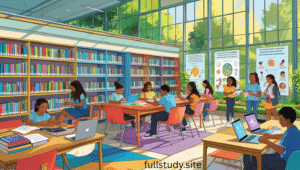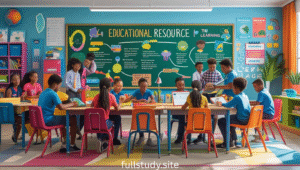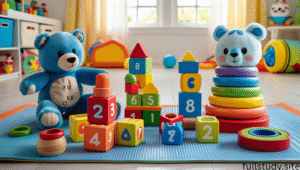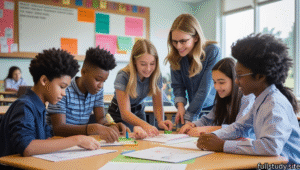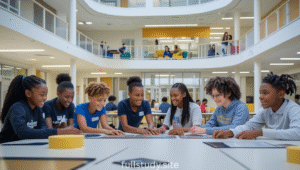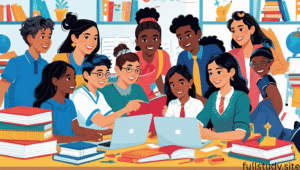
Your Passport to a Fulfilling Career
Enrolling in early childhood education courses is a wise and rewarding move if you have a strong desire to support young children’s learning and development. These programs are intended to give you the information and resources you need to influence young minds during their most critical years, regardless of whether you’re just beginning your career or want to advance your abilities.
We’ll go over what early childhood education is, the different kinds of courses that are offered, important subjects that are covered, career options, and how to pick the best program for your objectives in this comprehensive guide. There are many adaptable alternatives to meet your preferences, regardless of whether you prefer in-person or online instruction.
Early Childhood Education: What Is It?
The development and instruction of children from birth until approximately age eight is the emphasis of early childhood education, or ECE. This period is crucial because it establishes the groundwork for a child’s social behaviour and lifetime learning.
Teachers that take courses in this area will gain a better understanding of curriculum preparation, classroom management, learning theories, and child development. You can promote young children’s cognitive, emotional, and physical development by taking early childhood education classes.
Why Pick an Early Childhood Education Career?
Being an early childhood educator is a calling, not simply a job. A child’s brain develops most during the first several years of life, and your work as an educator can have a long-lasting effect.
Taking early childhood education classes can change your life for the following reasons:
High Demand: Across the world, there is an increasing need for certified early childhood educators.
Personal Satisfaction: It is very satisfying to support the growth of young children.
Flexibility in the workplace: Graduates can work in public schools, daycare facilities, preschools, or even open their own childcare businesses.
Professional Development: A lot of programs offer degrees, certificates, or diplomas that can lead to leadership positions and promotions.
Course Types for Early Childhood Education
Your career objectives, degree of experience, and free time will all influence the route you take. The most popular categories of ECE courses are as follows:
1. Programs for Certificates
These are brief courses that give students a solid understanding of early learning, classroom management, and child development. Excellent for people who are new.
2. Programs for Diplomas
More in-depth instruction and practical placements are common features of diploma programs. These are perfect for people who prefer theory to practical experience.
3. Bachelor’s degrees
Associate degrees, which are usually two-year programs, can serve as a springboard for a bachelor’s degree and prepare students for entry-level roles.
4. Bachelor’s degrees
A four-year degree provides a thorough education and equips students for positions in education that are more advanced, such program director or lead teacher.
5. MOOCs and Online Courses
Online certificates and Massive Open Online Courses (MOOCs) provide flexibility for people with hectic schedules or working professionals.
6. Postgraduate Courses
Early childhood education master’s and doctoral programs are offered for individuals with an undergraduate degree who want to pursue specialised or research-focused employment.
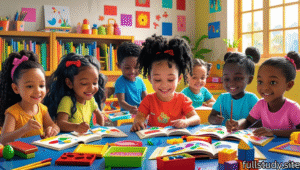
What Early Childhood Education Courses Will Teach You
Both academic knowledge and practical skills are intended to be provided by ECE programs. The following are some of the main subjects discussed:
1. Development of Children
Discover the behavioural patterns, emotional development, and developmental milestones of newborns, toddlers, and preschoolers.
2. Theories of Learning
Recognise how structured activities, play, and interaction help kids develop. The theories of Piaget, Vygotsky, and Montessori are important.
3. Safety and Health
Maintain children’s health by being knowledgeable about emergency protocols, hygienic practices, safe environment creation, and nutrition.
4. Planning the Curriculum
Create lesson plans and activities that are age-appropriate and encourage creativity, reading, and numeracy.
5. Control of Behaviour
Learn how to influence behaviour in constructive, beneficial ways.
6. Education That Is Inclusive
Discover how to help kids with a range of requirements, such as those who have behavioural issues, language hurdles, or learning disabilities.
7. Community and Family Involvement
Learn how to establish community-based learning settings and cultivate partnerships with families.
Leading Online Resources for Courses in Early Childhood Education
Online learning environments are a great place to start if you’re searching for flexible learning possibilities. Here are some trustworthy suppliers:
Coursera: Provides courses from academic institutions such as the University of London and Yale. There are certificates that can be stacked towards degrees.
edX: Offers courses in early childhood education from MIT, Harvard, and other prestigious universities.
FutureLearn: Focusses on ECE programs in the UK and frequently offers micro-credential possibilities.
Udemy: Lifetime access to reasonably priced, introductory ECE courses.
Open University’s OpenLearn provides free introductory courses in pedagogy and child development.
The Significance of Certification and Accreditation
Make sure an early childhood education course is accredited by a reputable organisation before enrolling in it. The course’s adherence to professional and academic standards is guaranteed by accreditation.
Seek out courses approved by:
The United States’ National Association for the Education of Young Children (NAEYC)
Educator Preparation Accreditation Council (CAEP)
UK’s Ofsted
The Quality Authority for Children’s Education and Care in Australia (ACECQA)
Obtaining certification from these organisations also increases your chances of finding work and advancing in your profession.
Opportunities for Employment Following ECE Course Completion
The variety of employment opportunities offered by early childhood education degrees is one of their biggest advantages. You can pursue the following roles:
Teacher of Preschool
Provider of Daycare
Assistant to the Teacher
Expert in Early Intervention
Director of a Childcare Centre
A Special Education Assistant
Childcare Provider at Home
Curriculum Creator
Consultant for Education
You might also work as a researcher, policy advisor, or college-level teacher with more education.
Things to Think About Before Signing Up for an ECE Course
1. Study Mode: Are you more comfortable with totally online, hybrid, or in-person instruction?
2. Length
While degrees can take years to complete, certificate programs can be completed in a matter of months. Choose according to your objectives and availability.
3. Expense and Assistance
Examine payment plans, grants, and scholarships. Online courses that are both free and inexpensive are also readily accessible.
4. Possibilities for an internship or practicum
Practical experience is priceless. Employers value the practical experience that programs with placements provide.
5. Reviews and Reputation
Examine reviews and testimonies, as well as the institution’s history of matching graduates with suitable positions.
FAQs Regarding Courses in Early Childhood Education
Does employment in early childhood education require a degree?
A: Not all the time. Although more education might lead to better chances, many entry-level jobs accept certificate or diploma holders.
Is it possible for me to learn early childhood education online?
A lot of recognised universities do provide online courses; some even include virtual practicum components.
How much time does it take to finish a course?
A: Depending on the program, degrees can take up to four years, diplomas one to two years, and certificates three to six months.
What abilities do I require?
A: In this line of work, patience, empathy, communication, creativity, and organisational abilities are all critical.
Concluding Remarks: Make an Investment in Your Own and a Child’s Future
Taking early childhood education classes is a commitment to raising the future generation, not merely a step towards a career. Now is a terrific moment to engage in your professional growth because there are many job pathways available, flexible learning options, and easily accessible online platforms.
Early childhood education offers a significant and fulfilling professional path, regardless of your interests in working in childcare, influencing education policy, or working in a preschool. Therefore, make the first move now and begin changing the lives of young children tomorrow.



